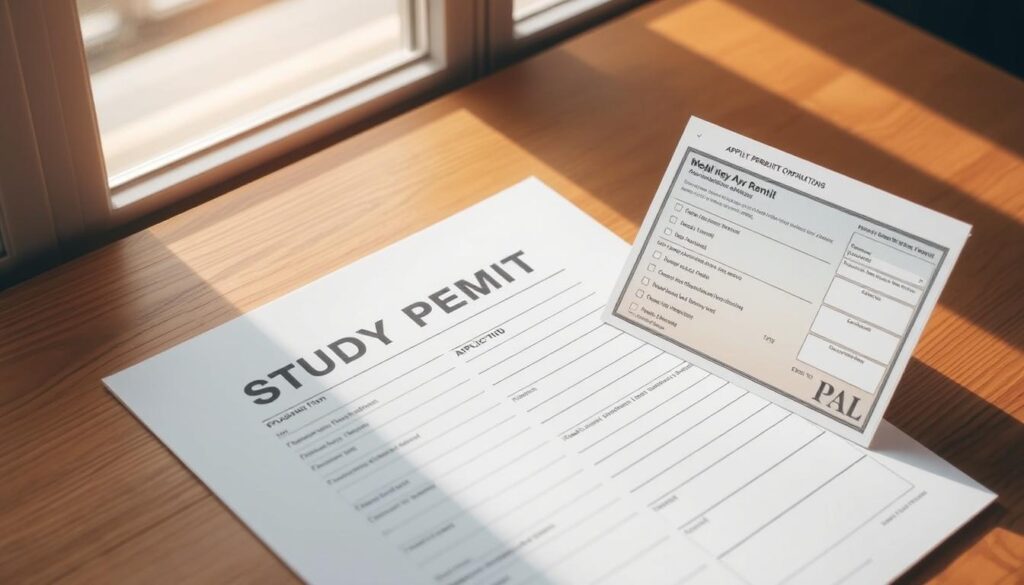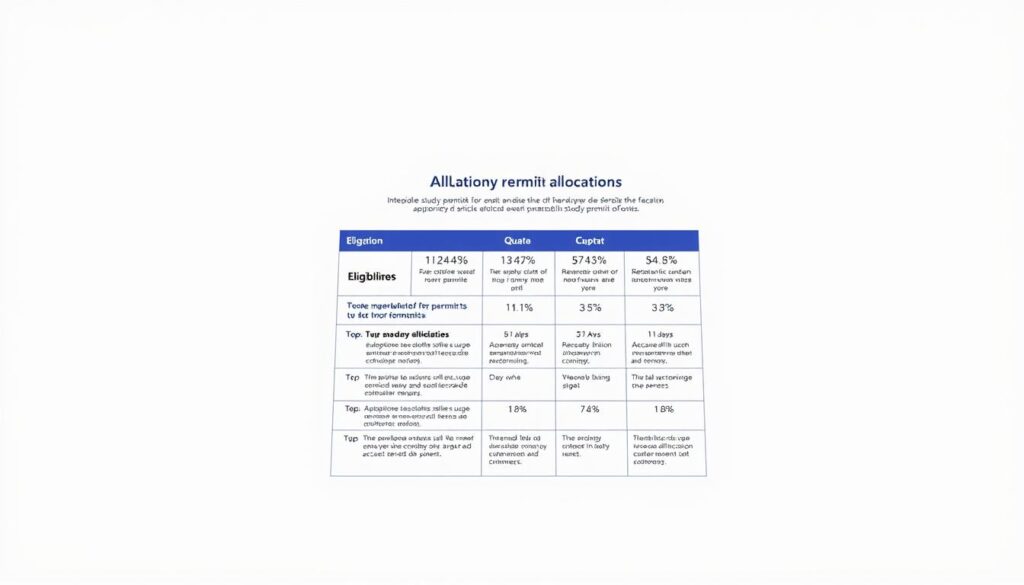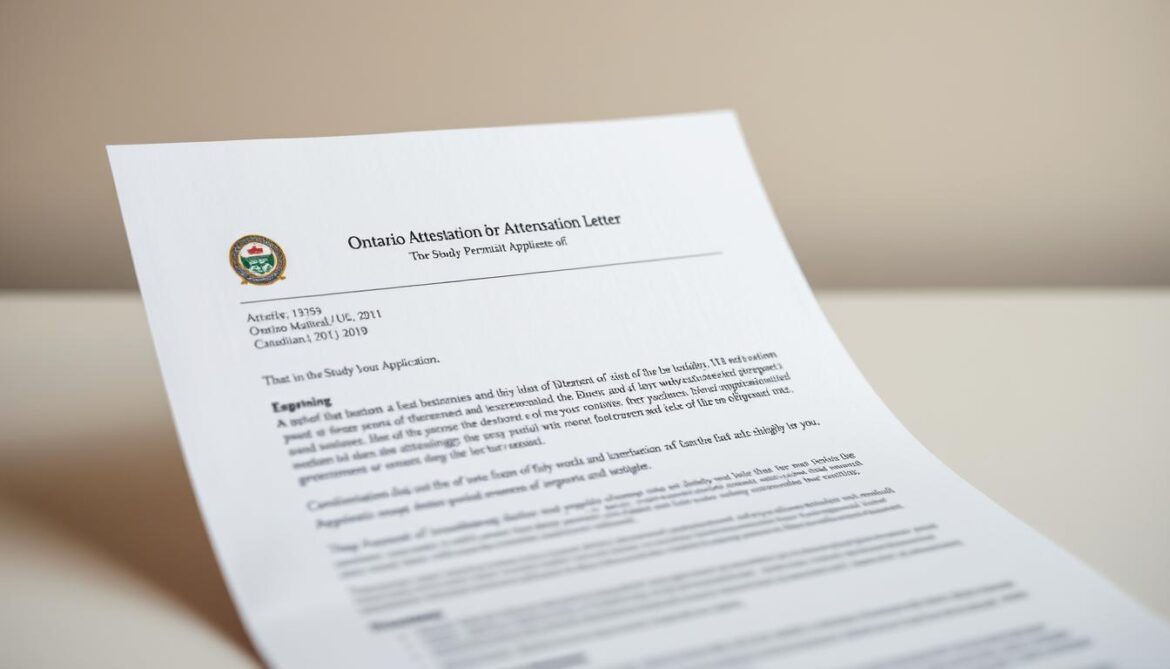Did you know Canada plans to approve 360,000 study permits in 2024? To manage this cap, the government introduced the Provincial Attestation Letter (PAL) system. This document confirms your allocated spot under the new rules.
Most international students now need a PAL for their study permit application. It applies to undergraduate and non-degree programs, with exemptions for master’s and PhD candidates until 2025. Each province handles attestations differently—Ontario uses PALs, while Quebec requires CAQs.
You must submit your PAL with your visa application. The letter remains valid until January 21, 2025, for the current cap year. Some universities, like Western, also require tuition deposits of $2,000-$2,500.
For official details, visit the Canada visa portal. IRCC will transition to new application systems in 2025, so plan accordingly.
What Is an Ontario Attestation Letter (PAL)?
Canada’s new PAL system ensures fair distribution of study permits across provinces. This document confirms your spot under the federal cap, balancing student intake with local resources.

Definition and Purpose of a PAL
A Provincial Attestation Letter (PAL) is an official confirmation of your allocated study space at a DLI (Designated Learning Institution). It includes your full name, birth date, and address, linking your application to Ontario’s quota of 235,000 permits in 2024.
IRCC defines it as a tool to prevent oversubscription in high-demand provinces. For example, Western University issues PALs with “ON25-” prefixes to track allocations.
Why the Canadian Government Requires a PAL
The federal cap system ensures provinces like Ontario don’t exceed education and housing capacities. Unlike Quebec’s CAQ, which combines study authorization, PALs focus solely on verifying genuine admissions.
Key reasons for PALs include:
- Maintaining education quality by limiting overcrowded classrooms
- 96% of Ontario’s permits go to public institutions
- Preventing fraud by tying permits to verified DLI acceptances
Family applications must include PALs for each member, even if submitted together. This ensures transparency under the new rules.
Who Needs an Ontario Attestation Letter?
Not all international students need a PAL for their Canadian study journey. The requirement depends on your program level and immigration status. Below, we break down who must secure this document and who can skip it.

Study Permit Applicants Requiring a PAL
Most undergraduate and college program applicants need PAL in 2024. This includes:
- New students applying for diploma or certificate programs
- Those enrolling in non-degree courses at public colleges
- Applicants switching DLIs without a valid study permit
Private career colleges in some provinces also fall under this rule. Always check your institution’s designation.
Exceptions to the PAL Requirement
Canada exempts certain groups from the PAL rule to streamline processes. You won’t need one if you’re:
- A master’s or PhD candidate (until 2025)
- An exchange student at a partnered university
- In K-12 schools or vocational training (DVS/AVS programs in Quebec)
- A protected person with verified IRCC status
Family reunification cases and Global Affairs Canada scholars also qualify for exemptions.
How to Get Your Ontario Attestation Letter
Securing your study permit starts with obtaining the right documents. Your designated learning institution (DLI) will guide you through the PAL process, ensuring you meet federal and provincial requirements.

Step-by-Step Application Process
Follow these steps to request your PAL:
- Accept your offer from a DLI and confirm enrollment.
- Pay tuition deposits (e.g., $2,500 for undergraduates at Western University).
- Submit a PAL request through your institution’s portal (e.g., Choose Western Portal for undergrads).
Processing times vary: graduate students often receive PALs in 1–2 days, while undergraduates wait 5–10 days.
Documents and Fees Required
Prepare these documents before applying:
- Passport copy
- Letter of Acceptance (LOA)
- Proof of funds (e.g., bank statements)
- Deposit payment receipt
Note: English proficiency conditions must be met before PAL issuance. Fees are non-refundable unless transferring between Western’s graduate programs.
After receiving your PAL, apply for your study permit immediately. IRCC’s system will transition in March 2025, so avoid delays. Track deposit clearance via your Student Center and download your PAL from the institution’s portal.
Validity and Expiry of Your PAL
Understanding the validity period of your PAL is crucial for a smooth study permit process. This document aligns with Canada’s annual cap system, meaning its expiry date depends on the federal allocation year.
How Long Your PAL Remains Valid
Your PAL’s validity is fixed to the cap year it’s issued under. For example, 2024 PALs expire on January 21, 2025, even if issued later in the year. This ensures fairness in study permit distribution.
Key details to note:
- 2024 cap year: January 22, 2024 – January 21, 2025
- 2025 cap year: Expected January 22, 2025 – January 21, 2026
- Expired PALs cannot be reused for reapplications
When You Need to Renew Your PAL
Renewal is required if you:
- Switch programs (e.g., from undergraduate to graduate studies)
- Transfer between DLIs within the same province
- Reapply after a study permit refusal
Exception: Quebec’s CAQ follows separate renewal rules.
| Scenario | PAL Action Required |
|---|---|
| Program level change | Renew with updated LOA |
| DLI transfer (Ontario) | New PAL from new institution |
| Study permit refusal | Reapply with fresh PAL |
Always verify your PAL’s issue date against the current cap year. Delays could affect your study permit approval timeline.
Applying for a Study Permit with Your PAL
Once you receive your PAL, the next step is applying for your study permit. This document confirms your spot under Canada’s annual cap, but submitting it correctly is just as important.

Submitting Your PAL to IRCC
Include your PAL in your initial study permit application. IRCC cross-checks it with your Letter of Acceptance (LOA) and financial proofs. Missing documents cause delays.
Key requirements for submission:
- PAL + LOA: Must match your program level and DLI details.
- Financial proof: Show funds for tuition and living costs.
- Passport copy: Ensure names align with your PAL.
Common Mistakes to Avoid
Errors can derail your permit application. Watch for these pitfalls:
| Mistake | Solution |
|---|---|
| Expired PAL | Check cap year validity before applying. |
| DLI mismatch | Verify your institution’s designation. |
| Missing program level | Undergraduate PALs can’t be used for master’s applications. |
| Name discrepancies | Update passport or PAL to match exactly. |
Pro tip: Biometrics appointments fill quickly—schedule yours right after submitting.
Ontario-Specific PAL Guidelines
Your choice of institution affects PAL availability and visa success rates. Ontario allocates 235,000 study permits annually, with 96% reserved for public DLIs. Private colleges receive only 4%, creating competitive hurdles for applicants.

Provincial Allocation and DLI Requirements
Public universities like Seneca College process provincial attestations faster, often within 5 days. Their higher visa approval rates stem from stricter compliance with IRCC standards. Private career colleges, such as triOS, face delays due to capped slots.
Key differences in allocation:
- Public DLIs: Priority processing, guaranteed PGWP eligibility.
- Private institutions: Limited PALs, no PGWP for non-degree programs.
- Language schools: Excluded from Ontario’s 2024 cap.
Differences Between Public and Private Institutions
Switching from a private to public institution requires a new PAL. Graduate programs at universities like Waterloo remain exempt until 2025, while private grad schools follow standard rules.
Compliance is strict:
- DLIs must verify enrollment before issuing attestations.
- Tuition deposits ($2,000+) lock your spot in the allocation.
- Name mismatches between PALs and passports cause rejections.
Note: Master’s students will join the provincial cap system in 2025—plan ahead if applying late 2024.
Studying in Other Provinces: PAL Variations
Each Canadian province manages study permits differently under the federal cap system. While Ontario uses PALs, other regions have unique processes for international students. These variations affect processing times and document requirements.
Quebec’s CAQ vs. PAL
Quebec requires a Certificat d’acceptation du Québec (CAQ) instead of a standard PAL. This dual-purpose document:
- Includes mandatory provincial attestation letter wording
- Takes 3-4 weeks to process
- Costs $117 CAD (non-refundable)
Unlike other provinces, Quebec’s system combines study authorization and permit verification. You’ll need both CAQ and PAL for some designated learning institution programs.
British Columbia and Alberta PAL Processes
Western provinces follow distinct allocation models:
British Columbia
- 83,000 permits split 53% public / 47% private
- Priority processing for universities like UBC
- 7-day average turnaround for PAL requests
Alberta
- 40,894 permits allocated for 2024
- Streamlined process for NAIT/SAIT applicants
- Rural institutions receive 22% of permits
Smaller provinces like PEI divide allocations by school – 59% for UPEI versus 35% for Holland College. Always verify your designated learning institution‘s specific requirements before applying.
What to Do If Your Study Permit Is Refused
Facing a study permit refusal can feel overwhelming, but knowing your next steps makes all the difference. Many applicants successfully reapply after addressing the issues in their initial submission. Your IRCC refusal letter holds the key to fixing mistakes.
Reapplying with a New PAL
If your study permit extension was denied, check these requirements before reapplying:
- Need PAL reissuance if yours expired or shows incorrect program details
- Updated Letter of Acceptance matching your current study permit extension goals
- Proof you’ve addressed refusal reasons (e.g., stronger financial evidence)
Western University’s International Student Advisors recommend:
“Submit new applications within 30 days of refusal to align with academic deadlines. Include a detailed explanation letter addressing each concern from your refusal notice.”
Seeking Assistance from Immigration Advisors
Complex cases often benefit from professional guidance. Consider consulting an advisor if:
- Your refusal cites vague reasons like “purpose of visit”
- You’ve had multiple refusals for the same program
- Your need PAL status changed due to switching institutions
Immigration lawyers can help with NOC code mismatches or eligibility disputes. Most international students see faster resolutions through Western’s ISA consultations—book early as slots fill quickly.
Note: Reapplication fees are non-refundable if your updated documents still don’t meet requirements. Always verify your DLI’s latest PAL issuance policies before resubmitting.
Conclusion
Navigating Canada’s study permit process requires careful planning. The PAL system ensures fair access to education while managing provincial quotas. With limited spots available, early application submission is key.
Before you apply study documents, double-check:
- Your PAL matches your program and DLI details
- Financial proofs meet IRCC requirements
- All forms are signed and dated
For 2024 applicants, act quickly—provincial allocations may run out. Always use official portals to avoid scams. Master’s students should note 2025 system changes.
Need help? Contact Cohen Immigration Law for personalized guidance. Start your journey today!



